The Intel Haswell Refresh Review: Core i7-4790, i5-4690 and i3-4360 Tested
by Ian Cutress on May 11, 2014 3:01 AM ESTCPU Synthetic Benchmarks
Content Creation - Cinebench
Based on MAXON’s CINEMA 4D animation software, Cinebench is used to determine the CPU and graphics performance via OpenGL. The software has gone through many iterations over the years, and here we use versions 10, 11.5 and 15 to compare single-threaded and multi-threaded CPU performance. As the generations increase, the software becomes more multithread aware and scales better, however for consistency with older results we keep the version 10 results in our database.
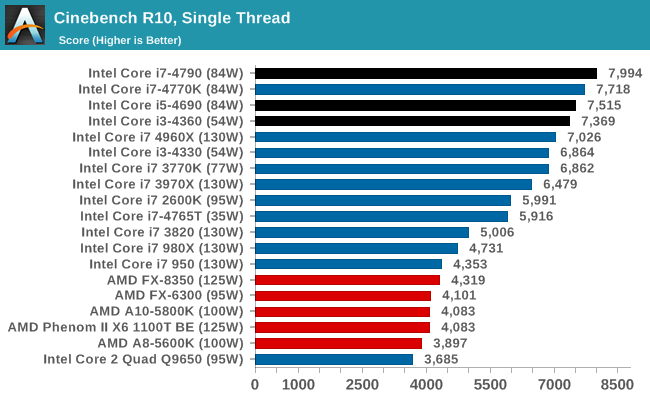

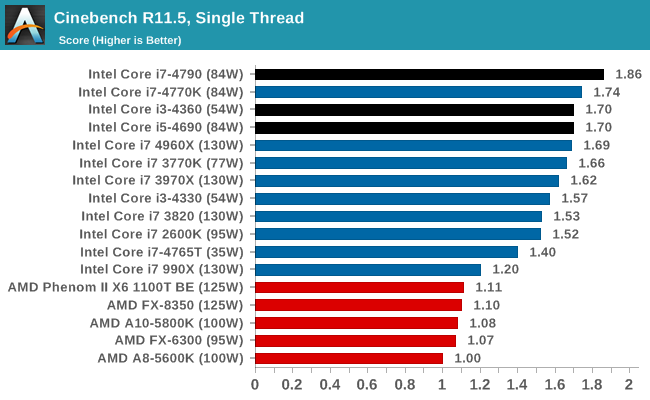
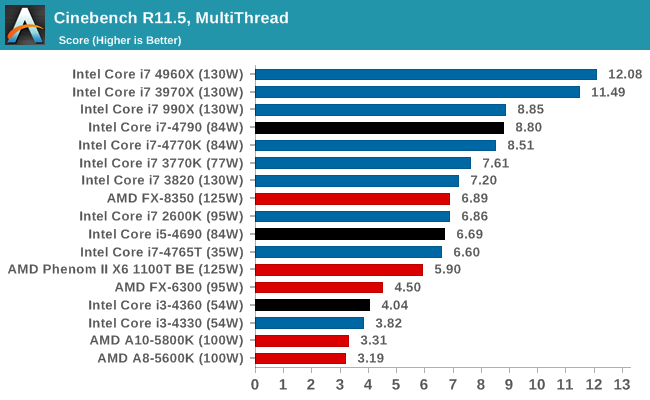

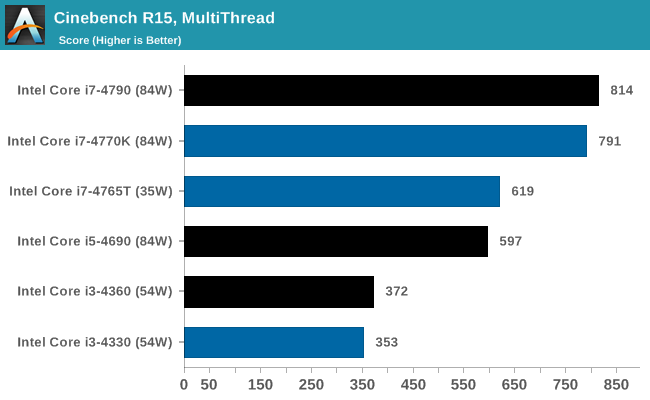
Video Conversion - x264 HD 3.03 Benchmark
Graysky's x264 HD test uses x264 to encode a 4Mbps 720p MPEG-2 source. The focus here is on quality rather than speed, thus the benchmark uses a 2-pass encode and reports the average frame rate in each pass.
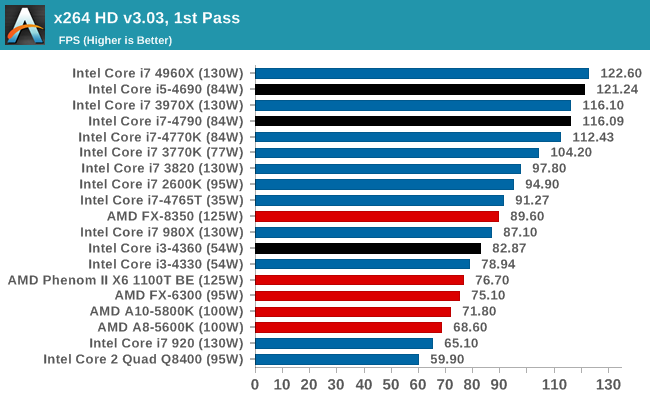

Encryption –TrueCrypt v0.7.1a: link
TrueCrypt is an off the shelf open source encryption tool for files and folders. For our test we run the benchmark mode using a 1GB buffer and take the mean result from AES encryption.
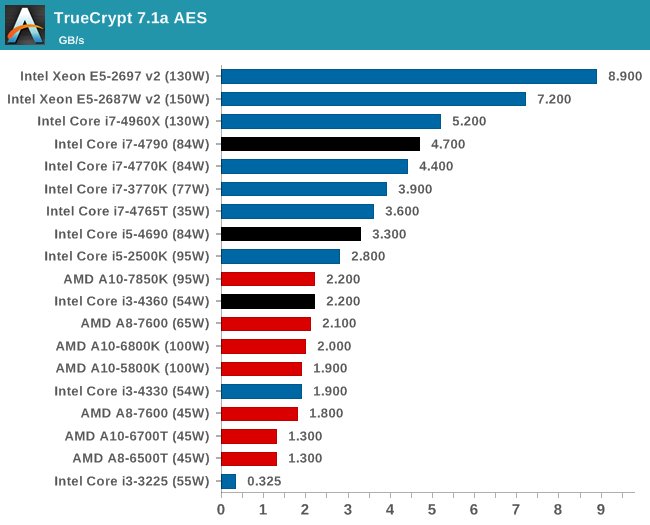
Synthetic – 7-Zip 9.2: link
As an open source compression tool, 7-Zip is a popular tool for making sets of files easier to handle and transfer. The software offers up its own benchmark, to which we report the result.
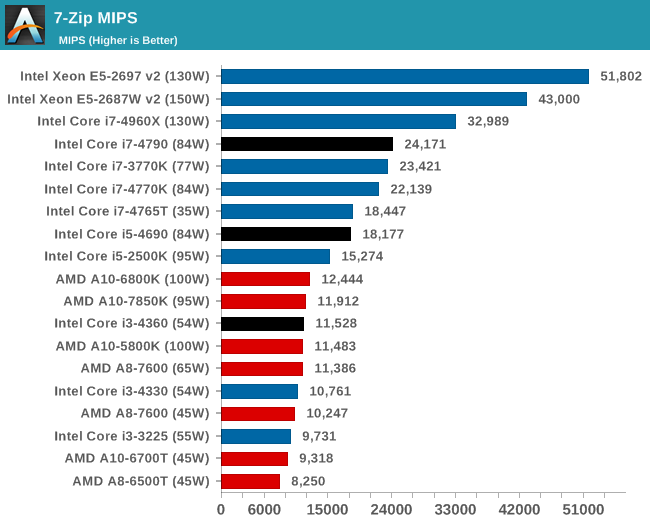
Rendering – PovRay 3.7: link
The Persistence of Vision RayTracer, or PovRay, is a freeware package for as the name suggests, ray tracing. It is a pure renderer, rather than modeling software, but the latest beta version contains a handy benchmark for stressing all processing threads on a platform. We have been using this test in motherboard reviews to test memory stability at various CPU speeds to good effect – if it passes the test, the IMC in the CPU is stable for a given CPU speed. As a CPU test, it runs for approximately 2-3 minutes on high end platforms.
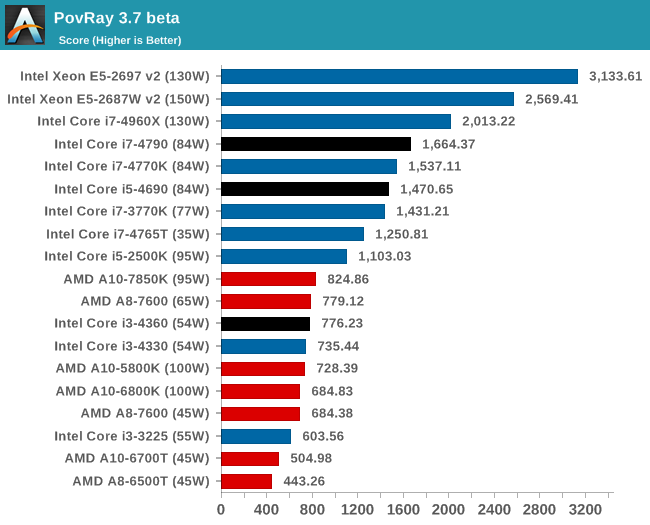
Console Emulation –Dolphin Benchmark: link
At the start of 2014 I was emailed with a link to a new emulation benchmark based on the Dolphin Emulator. The issue with emulators tends to be two-fold: game licensing and raw CPU power required for the emulation. As a result, many emulators are often bound by single thread CPU performance, and general reports tended to suggest that Haswell provided a significant post to emulator performance. This benchmark runs a Wii program that raytraces a complex 3D scene inside the Dolphin Wii emulator. Performance on this benchmark is a good proxy of the speed of Dolphin CPU emulation, which is an intensive single core task using most aspects of a CPU. Results are given in minutes, where the Wii itself scores 17.53; meaning that anything above this is faster than an actual Wii for processing Wii code, albeit emulated.
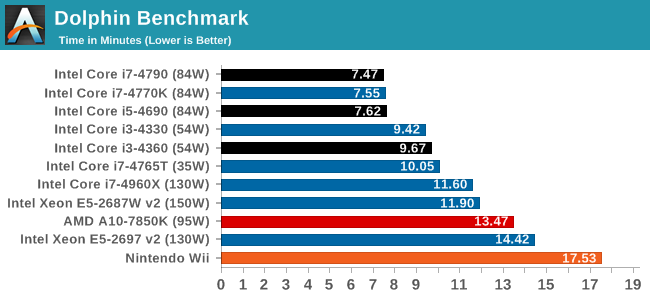
Dolphin relies very much on architecture as well as CPU single thread speed. It would also stand to reason that there is a small about of thread switching going on, given how far off the i3 and i7-4765T CPUs are.










130 Comments
View All Comments
mikato - Thursday, May 15, 2014 - link
Antronman- your stupid Bing link does not say that being an enthusiast means someone deeply involved in the construction of computers or extreme overclocking. Give me a break, master lamer. Just throwing out a link doesn't make something true. Pretty much everyone reading this article is an enthusiast. Not just that, but he is commenting and listing his computer specs. Come on. Go spread your lame BS somewhere else because I'm all out of patience for it this morning.royalcrown - Wednesday, May 14, 2014 - link
The one thing I'd upgrade on yours is the 660. Even coming from a 680, I was surprised at the difference between that and my current 780ti. IMO go for a vanilla 780, you'll be pleased I bet.mikato - Thursday, May 15, 2014 - link
"Because enthusiasts have the money, they will always buy the new parts because they're new."Nope. That is some kind of warped perception of reality. Do enthusiasts require the newest part to get through life? Do enthusiasts never build a computer to last a few years? Do enthusiasts have unlimited money, or pretty much care about nothing else in life besides the newest computer parts?
Please provide bing link to confirm your answers, lol.
jamescox - Sunday, May 11, 2014 - link
Not much of interest with this refresh. For most consumers, anything in the last few generations of cpus offer sufficient processing power. I don't think this is going to change until we get a major form-factor change to something more gpu centric. The overclocking chips coming out later may be of interest, but I don't know if I will buy one. I have been wondering if anyone will integrate a thin vapor chamber instead of just a "lid"; this seems like it would handle hot spots and such, but it may not be worthwhile.Samus - Sunday, May 11, 2014 - link
If my brand new H87 board doesn't run broadwell in 6 months, I'm going back to AMD on principle. Not since the 965/975x has a sequel processor not supported the previous gen chipset with the same socket (in that case, the Intel 30 series chipset, which supported 1333FSB.) That was 7 years ago.If Broadwell is simply a die shrink, why the hell would they abandon millions of 80-series motherboards other than to alienate people back to AMD?
KAlmquist - Monday, May 12, 2014 - link
Actually, you are wrong about that. The B65, Q65, and Q67 chip sets only support Sandy Bridge, not Ivy Bridge.Samus - Monday, May 12, 2014 - link
Ohh wow yeah...damn intel are bastards with this crap. A new chipset just to support a die shrink?Ramon Zarat - Monday, May 12, 2014 - link
Artificial market segmentation is indeed an highly anti-consumer business practice, especially when abused to the extent Intel do it.hasseb64 - Monday, May 12, 2014 - link
5 years ago, this release would have been a single news flash not an article, not blaming the sites, because there are no news/momentum in DIY-PC anymore.milkMADE - Monday, May 12, 2014 - link
I think you meant i7 4790k...as the non k is 4790."To that end, Intel is going to release ‘Devil’s Canyon’ in due course. Devil’s Canyon has no official SKU name yet (i7-4970K or i7-4770X are my best guesses)"
4970k would make me think the successor to the 4960x ivybridge-e 6core.